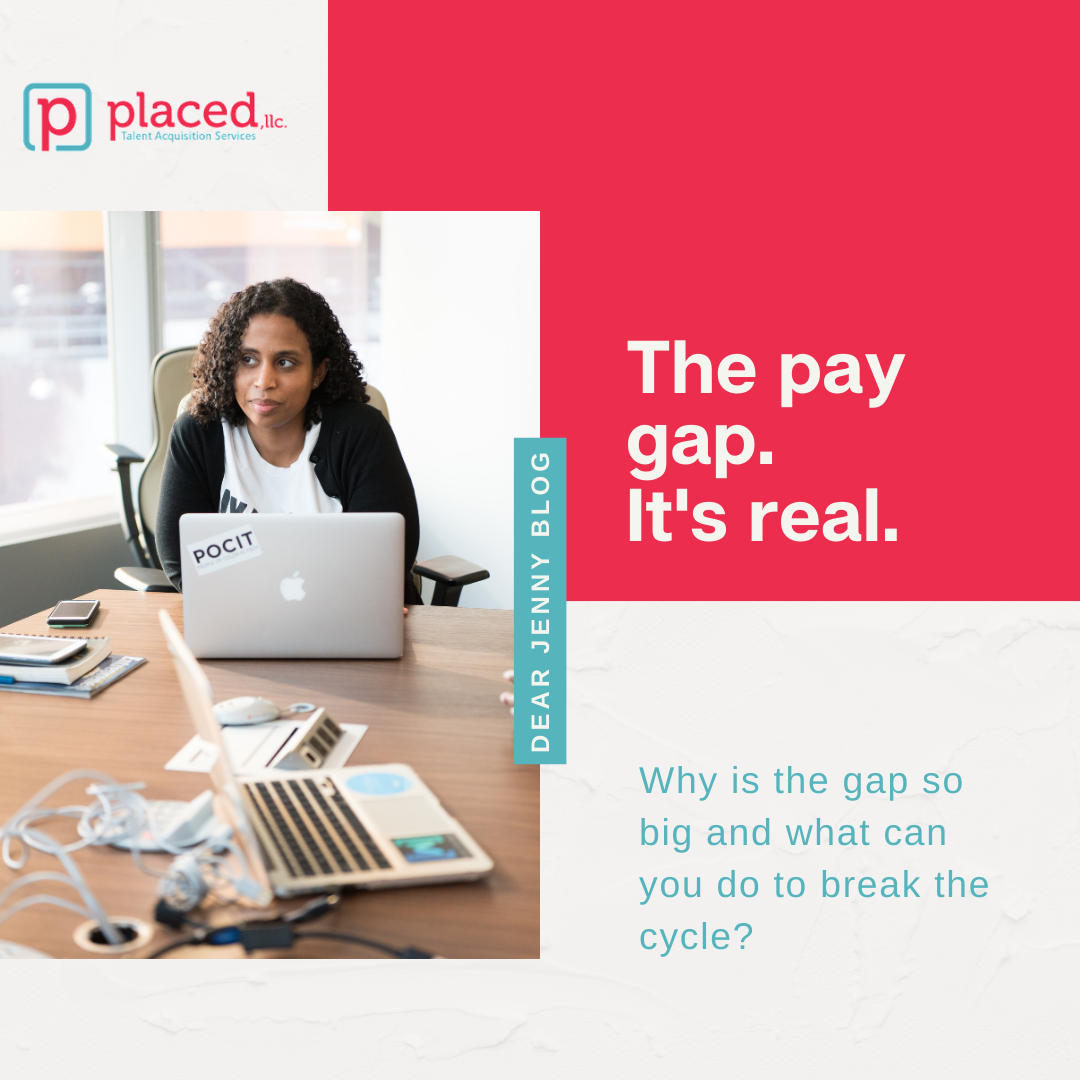
The Very Real Gender Pay Gap
Dear Jenny,
Is the pay gap a real thing? I got into a little debate with a co-worker who was telling me that the pay gap doesn’t exist anymore. I don’t think that’s true, and I’d love to hear your opinion.
Thanks,
Seeking the Truth
Dear Seeking the Truth,
It’s crazy to believe that in 2020 the pay gap is still a massive issue for women across the country. It hasn’t magically disappeared, although wouldn’t it be nice if it did. Instead, the reality is that women, particularly women of color, make significantly less than men, averaging to a $400,000 gap in a 40 year career. This stat and the rest of the stats in this blog are from an American Progress article on the pay gap.
 Let’s get into it. First, it’s important to understand that the common phrase “women make $0.75 to every $1 a man makes” isn’t necessarily true. Asian women, on average, make $0.90 to every $1 and white women make $0.79. The gap is more dramatic for black women, who only make $0.62 and it only goes down for American Indian women and Hispanic women coming in at $0.57 and $0.54. That is basically half. Women of color have larger wage gaps because of gender bias, racial, and ethnic bias that exist in the workplace.
Let’s get into it. First, it’s important to understand that the common phrase “women make $0.75 to every $1 a man makes” isn’t necessarily true. Asian women, on average, make $0.90 to every $1 and white women make $0.79. The gap is more dramatic for black women, who only make $0.62 and it only goes down for American Indian women and Hispanic women coming in at $0.57 and $0.54. That is basically half. Women of color have larger wage gaps because of gender bias, racial, and ethnic bias that exist in the workplace.
Now, we can all agree those numbers are embarrassing, but why is the gap such a real thing?
Remember in elementary school, when you went around the room to share what you wanted to be when you grew up? I do, and I remember most of the girls wanting to be moms, teachers, or princesses. These are all genuinely amazing pursuits – I’m a mother myself, so I understand the sacrifices it takes to be a mom. And teachers work their tails off for their jobs. And princesses… well, I’m not going to touch that one. But the point is that these are so-called women’s jobs, which are jobs that have historically had majority-female workforces, and tend to offer lower pay and fewer benefits. Is this completely and totally unfair? Yes. It absolutely is.
 So let’s get to a topic that I see in so many of the women candidates that I help place – a work gap from raising kids. I think that we can all agree that you learn a ton of transferable skills from being a mother. These include patience, clear communication, working well under stress, and multitasking. However, not all employers see it that way. Because of the time taken off by women, men, by definition, have more years of experience. When women do return to work, they tend to work fewer hours to accommodate caregiving and other unpaid obligations, which means lower hourly wages and fewer benefits compared to full-time workers. As a mom, this one really boils my blood.
So let’s get to a topic that I see in so many of the women candidates that I help place – a work gap from raising kids. I think that we can all agree that you learn a ton of transferable skills from being a mother. These include patience, clear communication, working well under stress, and multitasking. However, not all employers see it that way. Because of the time taken off by women, men, by definition, have more years of experience. When women do return to work, they tend to work fewer hours to accommodate caregiving and other unpaid obligations, which means lower hourly wages and fewer benefits compared to full-time workers. As a mom, this one really boils my blood.
Ever been asked to share your salary history with a hiring manager? For women, this can be so problematic since pay discrmination can literally follow someone from job to job. If you are a woman in the position of having to share your salary history, and you want to break the cycle, along with your salary, include a letter explaining what you’d like your new salary to be and why. Be your own advocate and break the cycle for yourself, because the system won’t do it for you.
 There is a law protecting employees from gender-based pay dscrimanation that passed in 1963, but that clearly hasn’t stopped the pay gap from existing. Discrimination is still rampit, especially in workplaces where speaking up is discouraged, or even punishable.
There is a law protecting employees from gender-based pay dscrimanation that passed in 1963, but that clearly hasn’t stopped the pay gap from existing. Discrimination is still rampit, especially in workplaces where speaking up is discouraged, or even punishable.
I wanted to make sure I touched on the wage gap challenges for people living intersectional realities—such as transgender women and immigrant women. While the data isn’t there yet to be able to show just how severe the gap is for these individuals, they face the challenges of bias and phobia in the workplace. I recognize that challenge and as soon as more data is available, I’ll do a blog post just for them.
 Sincerely,
Sincerely,
Jenny


